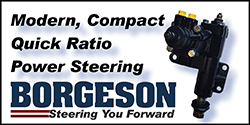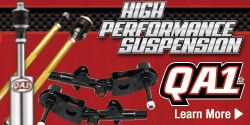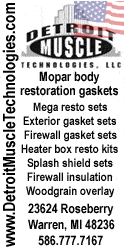Might be safe to assume he is no smarter than any of us. Or not the sharpest knife in the drawer just like you and me.Maybe not, but he's "not used his own words" so much that I just wonder what he does know. I mean heck, I'm FAR from the sharpest knife in the drawer, but I can diagnose my way out of a good bit.
You are using an out of date browser. It may not display this or other websites correctly.
You should upgrade or use an alternative browser.
You should upgrade or use an alternative browser.
28* initial timing for a 318? How can that be?
- Thread starter Bewy
- Start date
-
AJ/FormS
68 Formua-S fastback clone 367/A833/GVod/3.55s
- Joined
- Jan 19, 2014
- Messages
- 26,608
- Reaction score
- 13,849
IMO,
(I have to say this nowadays to not get slaughtered by the self appointed gurus of Mopardom, here);
for a Street SBM, which is all I work on; these are my opinions except as noted.
IMO-1,
After the mixture screws are synced to the transfers, to cure the Tip-in sag,
the engine will pretty much tell you how much MINIMUM idle-timing she wants by your target Idle-speed; Which is chosen;
If you have an auto-trans, by whatever rpm doesn't clang the sunshell/lurch the car, when shifting from N/P into gear. Or
If you have a manual trans; by how slow you want to be able to drive, with your chosen gears/ versus how much oil-pressure your valve-gear needs, to not to gall the parts.
The maximum Idle-timing can actually fall somewhere past 30 or even 40 degrees, but just don't try to drive it away with numbers like that, cuz detonation is is not your friend.
IMO-2
SBM Street cams can generally be plugged into a window of
220 to 250 degrees @050, which is 30 degrees which represents 4 to 5 basic cam sizes. Overlap will typically run from about 50 to 75 degrees.
In my EXPERIENCE, having run at both ends of the scale and inbetween,
any of these can idle very well, on as little as 5* Idle-timing; with a free-flowing over-sized exhaust system, and headers, just by getting the T-slot sync set right, and the ring gaps/skirt clearances set Not too tight.. and
not once have I needed or wanted to, run more than 14degrees of Idle-timing; even with the 292/292/108 Mopar cam, which boasts 76* of overlap.
Furthermore, if you have an automatic, the first time your engine really cares about ignition timing, is at stall.
Otherwise;
The engine will tell always you when she gets too much by detonating and/or losing power. and
She tells you when it's not enough by being lazy on the throttle and /or lazy on low-rpm acceleration.
BOTH of which you have to interpret in light of the entire combo, including;
what the CCP might be, what gears /and stall the engine is stuck with, how heavy the car is, , the type of intake manifold on it, AND, your ability to get the AFR correct which at idle, can be a little tricky.
IMO-3
again; for a street SBM,
with a Manual trans, running more than 14* is gonna be trouble when trying to drive slow with a typical starter gear of 2.66 x 3.55= 9.44, good luck with that.
with an automatic, with a high stall,
1) run whatever you want, until it detonates. or
2) whatever it takes to connect the dots from stall to about 3500, without detonation. this is the lazy-man's way.
3) Remember; on the street, in first gear, at WOT; you will never feel the difference between best timing and 3 degrees short.
Top of Second you might, but, that Second gear is typically good for over 80mph, so now your engine is working against wind-resistance too, so yeah a loss of say up to 3 or 4% hp, will become noticeable, but, only after the tires stop spinning.
4) the slower you idle it, the more you will hear the cam, which is typically caused by a mucked up intake plenum, which is due to reversion and overlap. After the T-slot is synced, the only way to slow the idle down, is with less Idle-Timing.
IMO-4
and BTW
if you run a dual-plane/spreadbore intake with a tiny VS-carb, you can sometimes get away with excessive Power-Timing versus detonation. This gives you more flexibility with your other timing targets.
Ok so that's all I got.
>I'm not telling anyone what Idle-Timing to run, so don't jump on me.
>I'm telling you that you don't hardly need more than 5*, even with and up to the 292 Purple Cam. I have not tuned bigger, so I don't know bigger.
>MORE IS NOT NECESSARILY BETTER.
> More Idle Timing gets you more Idle Power.
If your engine needs more Idle Power, you might want to consider why.
Maybe your engine is tight. Maybe your atomization is poor. Maybe your exhaust is piling up. Maybe she's sucking air, or the fuel-level is too low. I mean, think it over.
(I have to say this nowadays to not get slaughtered by the self appointed gurus of Mopardom, here);
for a Street SBM, which is all I work on; these are my opinions except as noted.
IMO-1,
After the mixture screws are synced to the transfers, to cure the Tip-in sag,
the engine will pretty much tell you how much MINIMUM idle-timing she wants by your target Idle-speed; Which is chosen;
If you have an auto-trans, by whatever rpm doesn't clang the sunshell/lurch the car, when shifting from N/P into gear. Or
If you have a manual trans; by how slow you want to be able to drive, with your chosen gears/ versus how much oil-pressure your valve-gear needs, to not to gall the parts.
The maximum Idle-timing can actually fall somewhere past 30 or even 40 degrees, but just don't try to drive it away with numbers like that, cuz detonation is is not your friend.
IMO-2
SBM Street cams can generally be plugged into a window of
220 to 250 degrees @050, which is 30 degrees which represents 4 to 5 basic cam sizes. Overlap will typically run from about 50 to 75 degrees.
In my EXPERIENCE, having run at both ends of the scale and inbetween,
any of these can idle very well, on as little as 5* Idle-timing; with a free-flowing over-sized exhaust system, and headers, just by getting the T-slot sync set right, and the ring gaps/skirt clearances set Not too tight.. and
not once have I needed or wanted to, run more than 14degrees of Idle-timing; even with the 292/292/108 Mopar cam, which boasts 76* of overlap.
Furthermore, if you have an automatic, the first time your engine really cares about ignition timing, is at stall.
Otherwise;
The engine will tell always you when she gets too much by detonating and/or losing power. and
She tells you when it's not enough by being lazy on the throttle and /or lazy on low-rpm acceleration.
BOTH of which you have to interpret in light of the entire combo, including;
what the CCP might be, what gears /and stall the engine is stuck with, how heavy the car is, , the type of intake manifold on it, AND, your ability to get the AFR correct which at idle, can be a little tricky.
IMO-3
again; for a street SBM,
with a Manual trans, running more than 14* is gonna be trouble when trying to drive slow with a typical starter gear of 2.66 x 3.55= 9.44, good luck with that.
with an automatic, with a high stall,
1) run whatever you want, until it detonates. or
2) whatever it takes to connect the dots from stall to about 3500, without detonation. this is the lazy-man's way.
3) Remember; on the street, in first gear, at WOT; you will never feel the difference between best timing and 3 degrees short.
Top of Second you might, but, that Second gear is typically good for over 80mph, so now your engine is working against wind-resistance too, so yeah a loss of say up to 3 or 4% hp, will become noticeable, but, only after the tires stop spinning.
4) the slower you idle it, the more you will hear the cam, which is typically caused by a mucked up intake plenum, which is due to reversion and overlap. After the T-slot is synced, the only way to slow the idle down, is with less Idle-Timing.
IMO-4
and BTW
if you run a dual-plane/spreadbore intake with a tiny VS-carb, you can sometimes get away with excessive Power-Timing versus detonation. This gives you more flexibility with your other timing targets.
Ok so that's all I got.
>I'm not telling anyone what Idle-Timing to run, so don't jump on me.
>I'm telling you that you don't hardly need more than 5*, even with and up to the 292 Purple Cam. I have not tuned bigger, so I don't know bigger.
>MORE IS NOT NECESSARILY BETTER.
> More Idle Timing gets you more Idle Power.
If your engine needs more Idle Power, you might want to consider why.
Maybe your engine is tight. Maybe your atomization is poor. Maybe your exhaust is piling up. Maybe she's sucking air, or the fuel-level is too low. I mean, think it over.
Is the message wrong or the way he presented it wrong? Did you see Rusty's results? I thought he did a good job presenting it. But still I guess one could agree or disagree with his conclusion. Maybe @RustyRatRod can post the link to his testing for those who haven't seen it.The message is wrong because of the way it’s being presented.
Not saying you should build for sound only but sound is a big part why we love these engines and why electric ain't overly appealing.Maybe. I mean I get what your saying , but just listen to it. You have to admit that sound is so cool.
TT5.9mag
Two atmospheres are better than one
I have seen his results. He did do a good job. And I could also agree or disagree with his conclusions. I still think the message is wrong because of the way @Bewy presents it. His methods seem to indicate that MVA is better always and should be used by everyone, and he presents highlighted quotes from superhero’s saying why and how that’s true. Not showing the rest of the story for why that’s necessary in those situations. It’s misleading at the very least.Is the message wrong or the way he presented it wrong? Did you see Rusty's results? I thought he did a good job presenting it. But still I guess one could agree or disagree with his conclusion. Maybe @RustyRatRod can post the link to his testing for those who haven't seen it.
My 451 likes 14-16 and all my old 383 combo's liked 20-22.
A better thread would be tuning when changing from a dual plane to a single plane intake. lol
A better thread would be tuning when changing from a dual plane to a single plane intake. lol
if you have an automatic, the first time your engine really cares about ignition timing, is at stall.

more like an ongoing state of existence, really.I feel like I'm missing something is this an argument continued from another thread ?
It's my way or the highway, pal. lolI feel like I'm missing something is this an argument continued from another thread ?
but... but... big block pontiac and HEI! that's the be all, end all man.I'm beginning to think he doesn't use his own words because he doesn't have any of his own since he really has no understanding himself. All he has is information from other sources.
*makes long protracted fart sound*
i think you've been skipping all the "i have a 318 and help me pick a cam" threads...Yeah, you’re right. It’s probably over 50% that have too much cam or not enough compression.
It still amazes me how many guys (not just here on FABO but everywhere) are more concerned about what idle SOUNDS like rather than how well it runs.
It’s a shame really.
But do they really say it's true to use MVA all the time? We don't know, because all we ever get are cherry picked paragraphs with lots of missing context.I have seen his results. He did do a good job. And I could also agree or disagree with his conclusions. I still think the message is wrong because of the way @Bewy presents it. His methods seem to indicate that MVA is better always and should be used by everyone, and he presents highlighted quotes from superhero’s saying why and how that’s true. Not showing the rest of the story for why that’s necessary in those situations. It’s misleading at the very least.
Icetech
Well-Known Member
My engine won't even idle decently below 26* i'm going to end up just locking it at 32... i was stressed bout it but everyone says a motor wants what it wants.. mine loved 40 but would be bad
P.S. AJ and i had a long talk about it and it's just what the cam wants...

P.S. AJ and i had a long talk about it and it's just what the cam wants...
Icetech
Well-Known Member
But you just replied to oneInitial timing threads…….(to include ported/manifold vacuum threads)…..
I’ll add those to the “do not respond” list……..with
-best oil
-best spark plugs
-302 heads
No one is changing anyone’s mind on those topics.
Sumting wongMy engine won't even idle decently below 26* i'm going to end up just locking it at 32... i was stressed bout it but everyone says a motor wants what it wants.. mine loved 40 but would be bad
P.S. AJ and i had a long talk about it and it's just what the cam wants...

Icetech
Well-Known Member
Everything is an argument from another thread from 10 years agoI feel like I'm missing something is this an argument continued from another thread ?
Does anyone know where the tuning 101 thread is, maybe start there.
My engine won't even idle decently below 26* i'm going to end up just locking it at 32... i was stressed bout it but everyone says a motor wants what it wants.. mine loved 40 but would be bad
P.S. AJ and i had a long talk about it and it's just what the cam wants...

That’s about the most idiotic advice you could get. I’d rather use MVA and try and get a curve with it than lock it out.
AJ is NOT a cam whisperer. And that’s horrible advice. Do NOT do it.
Rise above the ignorance of poor, lazy tuners and tuning. I’m betting I can make your engine idle with less than 24 initial and get a curve in it.
Half way through 2025 and we still haven’t corrected tuning nonsense and lies.
i think you've been skipping all the "i have a 318 and help me pick a cam" threads...
I stay out of those for the most part. You can run about 50 different cams from 10 different manufacturers and they’ll all be within 10 hp.
Icetech
Well-Known Member
AJ didn't tell me to lock anything out.. he just helped me understand some things... some people are able to do it in a civil manner without being insulting.. it's a nice way to beThat’s about the most idiotic advice you could get. I’d rather use MVA and try and get a curve with it than lock it out.
AJ is NOT a cam whisperer. And that’s horrible advice. Do NOT do it.
Rise above the ignorance of poor, lazy tuners and tuning. I’m betting I can make your engine idle with less than 24 initial and get a curve in it.
Half way through 2025 and we still haven’t corrected tuning nonsense and lies.
mderoy340
Well-Known Member
I run my 93 pump gas 360 @28* initial 34* mech total 48* vac cruise, ported vac. Eddy heads closed chamber, 251@.050, 3400 tight conc, low gear set A999, 4.10 gear, GV overdrive. Works great for me.AJ didn't tell me to lock anything out.. he just helped me understand some things... some people are able to do it in a civil manner without being insulting.. it's a nice way to be
Mattax
Just the facts, ma'am
This can be true. Especially if one is making a rational arguement and the participants are trying to reach a common goal - such as better understanding of some specific phenomenon. Thats not the case the case here, and I can name several others as well, who insist there is only one way, their way. If they seem successful, then perhaps they are right, but when they are discredited, then we know that what they are preaching is not so.I get it. Hard to trust the message if you don't trust the messenger. But that by itself doesn't mean the message is wrong.
I'll disagree with you on that. The message is wrong. If it was presented as "it depends" then it would be a different message.The message is wrong because of the way it’s being presented.
Yup. And we do what we can to make our stuff work. Not many of us have the luxury to do another engine build.Maybe it’s got too much camshaft, maybe it doesn’t have enough compression for the duration. Maybe, maybe, maybe.
Yes. More so we do not have a comparison with a mechanical advance curve set up that would mechanically allow the same initial thereby allowing the use of timed port strictly for leaner mixes. I'm not actually suggesting he do that now. Its a lot of work for someone who is satisfied with the current arrangement.I have seen his results. He did do a good job. And I could also agree or disagree with his conclusions. I still think the message is wrong because of the way @Bewy presents it. His methods seem to indicate that MVA is better always and should be used by everyone, and he presents highlighted quotes from superhero’s saying why and how that’s true. Not showing the rest of the story for why that’s necessary in those situations. It’s misleading at the very least.
I've seen a few people learn from some of the threads about timing, but can't recall any which devolved into pseudo-theoretical arguements changed any minds.But you just replied to oneAnd you are wrong.. some of us are just trying to learn, not have our minds changed.. it makes me nuts how much timing my motor wants and i just tried to learn why.
There was one thread where a person throught Chrysler used manifold vacuum source on a '66 273, and he went and checked the original carb. The carb had a timed port. So he learned something. But there was another thread where a similar thing happened, the person didn't beleivet Chrysler used a ported source so I suggested he go look for himself. We would then find out. He reported back that he discovered it was using ported. Somehow a post or two later he was back to saying I had it wrong. Go figure!
Last edited:
-
Similar threads
- Replies
- 47
- Views
- 7K
- Replies
- 10
- Views
- 3K
- Replies
- 55
- Views
- 7K
















